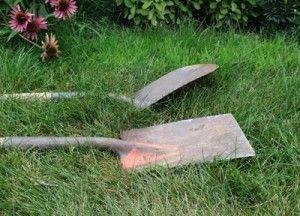The garden spade tool is used for all kinds of digging and edging. Its straight blade and low angle help push it deeper and deeper into the soil without much hassle. If you have a digging job, the garden spade is the best option to make it successful effortlessly. Besides, it is a versatile tool that can be considered the gardener’s best friend, as it can be used for multiple purposes. Our effective tool guide will tell you how.
Spade tool: Quick facts
| Type of spade | Shape | Purpose |
| Standard spade | Rectangular blade | All-purpose garden tool |
| Border spade | Smaller and lighter | Working in raised beds or narrow borders |
| Digging spade | Wider blade with rounded cutting edge | Best for edging |
| Pointed spade | Pointed cutting edge | Can get through stubborn, rocky soil easily |
| Transplanting spade | Elongated narrow blade | Helps get out the roots of plants without damage |
Spade tool vs shovel

Source: Pinterest
Many inexperienced individuals often mistake a shovel for a spade but trust us; both are as different as cheese from butter. The shovel has a concave shape with a pointed tip, while a spade is flat with a straight or pointed edge, depending on the type. Then again, the shovel has a longer shaft than the spade, and the size of its blade is also bigger. While a shovel is used for large-scale digging and turning the soil, a spade is best for delicate jobs, like getting the roots out or moving loose material.
The broader blade of the shovel is curved inwards and may come in an extra-long size or the form of a saw-tooth, depending on the purpose. But the blade of the spade tool is straight, shorter and in line with the shaft. The key difference lies in their functions, though. The shovel with its curved blade is efficient for digging deeper holes, and the spade is used for edging lawns, lifting sod, opening trenches or skimming weeds.
Spade tool: Different uses of spade
The garden spade is mostly used for light cultivation, as its ergonomic design makes it easier to cut through the earth, narrow edges and so on. It helps dig nicer and deeper holes for the plants’ roots to develop conveniently. Let us now learn about the different uses of a spade tool in the garden:
Turning the soil
Also known as spading (not surprised), this job involves mixing compost, fertilisers and other plant matter in the soil effectively. It helps loosen or aerate the soil for better root development and also improves access to the earthworms that benefit the plants. Spading also helps improve drainage and remove small, hazardous weeds that may cause damage to the plant.
The soil turn-over job is recommended during fall or early winter, as it gives the soil materials that you have added one full season to become active before you start planting seeds in early spring or summer. You can either dig one head deep (single digging) or two heads (double digging) using the spade. While the former is apt for regular roots, the latter process is mandatory for plants with a deeper root system, like potatoes or roses.
It does not matter if you are adding fresh compost to the soil or just turning over last year’s soil, the flat and sharp edge of your garden spade and its vertical angle is best suited for digging evenly throughout the garden.
Sod removal
It involves the act of removing unnecessary grass and its roots from the soil. Sod or turf is the entire grass system with its roots. It needs to be removed for creating flower beds or garden scaping. And a spade tool is best suited for the same. It helps cut through the matted roots of sod conveniently. The straight blade of the spade loosens the sod from its roots and removes it effectively.
The best time to remove sod is a few days after some good rain. If you try to do that while the ground is still wet, you will be working in a muddy mess. And if you choose to remove sod on dry soil, you will find the work more difficult than your expectations. Hence, the best time is after a few days of heavy rainfall. You can even water the soil and start working, in case there is no rain.
Take the spade and dig a 6-inches hole into the sod. Cut about 18 square inches of sod, use one edge of the spade and pry up a little. You can then slide the spade under the sod and lift it easily. Repeat the process for the rest of the sod you want to remove.
Digging holes
After removing the sod, you can use the spade to dig holes in your garden. You can dig smaller holes for planting flowers or tubers and larger ones for creating a backyard pond or a root cellar. It is best to go digging after a few days of rain. But make sure that the soil is not too wet, as you have to remove the sod first.
As discussed before, the garden spade is the best tool for this purpose. It helps dig with precision and measure the holes for planting your trees. Further, its flat design helps pry out unnecessary growth from the soil so that your perennials can grow freely and conveniently.
Note: While digging deeper holes into the garden soil, be careful not to damage any underlying utility lines. You may call the local utility office and check if they have anything buried in your backyard.
Edging
Creating edges gives your garden or backyard a clean and formal appearance and prevents grass and weeds from invading your flower beds or other plants’ growing space. It also helps separate two different features in your garden landscape, like flower beds and fountains, grass and flower beds, etc. Make it a point every year to check the edging in your garden and resize it using the spade tool and remove any grass that has managed to penetrate past the edge line. You should also re-cut the crisp edges using the spade tool to maintain the distinction.
The garden spade is straight and sharp, making it the best tool for creating and maintaining edges in your garden. To create a ground-only edge, you have to mark the edge with some spray paint. Face the bed and dig your spade 3-4 inches into the ground along the edge you are planning to create. Now, lift the soil out by kicking the flat part of your spade that helps bring the dirt up.
Transplanting
The spade is designed to penetrate deep into the soil, cut roots and remove plants easily without damage. Simple levering allows the plants to be gently removed from the ground. However, you should take some care not to dig too close to the plant, as you may damage the roots.
Dividing the plants also becomes easier using the spade tool. Some plants may need dividing when they outgrow the space provided to them initially. You can dig them up using the spade and move them to another location or give them away to your friends and relatives for transplanting.
Spade tool: Maintenance of garden spade

Source: Pinterest
The spade tools require very little maintenance, another reason for their preference and popularity among gardeners. All they need is regular sharpening to stay in use longer. If your spade blade gets dull, you can use an angle grinder to sharpen it. Also, you should prevent rusting and remove even tiny signs of rust from its blade.
See also: What is Hibiscus and how to grow it in your home?
Gardening: Transform your outdoors with a spade
The spade is a useful gardening tool that can be effectively used to make the space attractive and functional. It is used when preparing the soil for planting, digging trenches, and removing grass or weeds. One can use the spade to improve the aesthetic appeal of your garden. Create a fire pit using the spade and install suitable outdoor lighting for a perfect outdoor entertainment space.
Landscaping: Effortlessly dig and plant with a spade
The spade helps you design a beautiful outdoor space. Using a spade, you can create elegant garden beds, pathways, and borders. It helps you add texture and character to your home’s outdoor areas. Planting is easy using a spade. The flat head enables digging holes or removing plants. One must note that a garden spade is mostly suitable for loose soil. It may not work on compacted or rocky soil.
FAQs
How to choose spade material?
Stainless steel, carbon and hammered steel are considered the best spade materials. While carbon spades are lighter, steel spades have higher durability.
Are wood shafts best for the spade?
Wood is more durable than fibreglass shafts. If the latter breaks, replace it with wood.
What types of handles does a spade have?
A spade may have a straight, U-shaped or T-shaped handle. The U-shaped handles offer ergonomic efficiency, while the T-shaped and straight handles are easier to use. However, they may fail to transport soil as conveniently as a U-shaped one.
Can I use a spade for moving the earth?
The spade is used for light cultivation. If you want to move the earth, the shovel is the best tool.
What is dicing?
Sometimes, the spades are used to chop up organic materials in the soil to increase their efficiency. The process is known as dicing.
| Got any questions or point of view on our article? We would love to hear from you. Write to our Editor-in-Chief Jhumur Ghosh at [email protected] |
Housing News Desk is the news desk of leading online real estate portal, Housing.com. Housing News Desk focuses on a variety of topics such as real estate laws, taxes, current news, property trends, home loans, rentals, décor, green homes, home improvement, etc. The main objective of the news desk, is to cover the real estate sector from the perspective of providing information that is useful to the end-user.
Facebook: https://www.facebook.com/housing.com/
Twitter: https://twitter.com/Housing
Email: [email protected]











